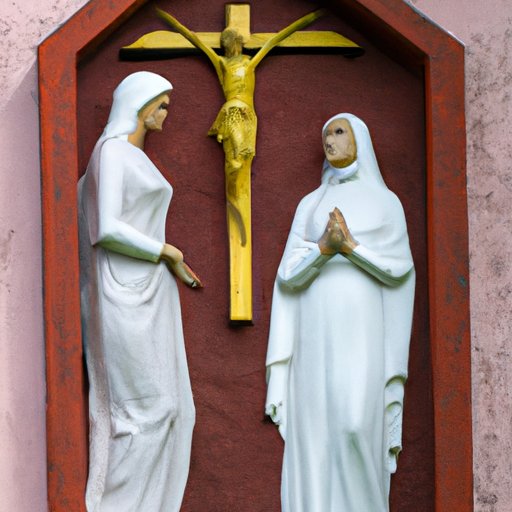Introduction
The Stations of the Cross, also known as the Way of the Cross or Via Crucis, is a religious devotion that commemorates Jesus Christ’s passion and crucifixion. It consists of a series of 14 stations that are representative of important events that took place during the final hours of Jesus’s life. This article aims to explore the history, meaning, and significance of the Stations of the Cross in the Catholic Church and other Christian traditions.
The History of the Stations of the Cross
The origins of the Stations of the Cross can be traced back to medieval Europe, where pilgrims would travel to sites of significance in Jerusalem to retrace Jesus’s final steps. However, it wasn’t until the 18th century that the 14-station format we know today was established.
The number of stations has varied throughout history, with some versions having as few as 7 and others having as many as 30. However, the 14-station format became the most widely accepted and has remained consistent since the 18th century.
The Stations were traditionally done through outdoor processions, but they are now commonly done inside churches as well. They are typically practiced during Lent, but many Catholic Churches have permanent installations that can be visited year-round.
Understanding the Meaning Behind Each Station of the Cross
Each of the 14 stations represents a specific event that occurred during Jesus’s journey to his crucifixion. The stations are as follows:
- Jesus is condemned to death
- Jesus receives the cross
- Jesus falls the first time
- Jesus meets his mother, Mary
- Simon of Cyrene helps Jesus carry the cross
- Veronica wipes the face of Jesus
- Jesus falls the second time
- Jesus meets the women of Jerusalem
- Jesus falls the third time
- Jesus is stripped of his garments
- Jesus is nailed to the cross
- Jesus dies on the cross
- Jesus is taken down from the cross
- Jesus is laid in the tomb
Each station has deep symbolism and significance in the Christian faith. They tell the story of Jesus’s sacrifice and the immense suffering that he endured for humanity’s sake. Each station offers an opportunity for reflection and a chance to connect with Jesus on a deeper level.
Walking the Way of the Cross
Walking the Stations of the Cross is a powerful and deeply moving experience. It allows one to physically and spiritually connect with Jesus’s sacrifice and reflect on the immense love that he had for humanity.
As one walks through each station, they can reflect on the meaning behind each one and how it applies to their own lives. For example, station 5, “Simon of Cyrene helps Jesus carry the cross,” reminds us that we should be open to helping others and carrying their burdens, just as Simon helped Jesus.
Reflecting on each station can help us to better understand Jesus’s sacrifice and how we can live our lives in a way that honors and glorifies it. The Stations of the Cross offer a way for us to connect with Jesus in a very personal and meaningful way.
The Role of the Stations of the Cross in the Catholic Church
The Stations of the Cross play an integral role in Catholic worship, particularly during Lent. They offer a way for Catholics to connect with Jesus’s sacrifice and reflect on their own lives.
During Lent, Catholics often attend Stations of the Cross services on Fridays, where they pray and reflect on each station. Many Catholic churches also have permanent installations of the Stations that can be visited year-round.
The Stations of the Cross are also a significant part of Catholic devotional life. Many Catholics choose to pray the Stations individually or in groups as a way of deepening their faith and connecting with Jesus on a personal level.
The Artistic Depictions of the Stations of the Cross
The Stations of the Cross have been depicted in countless works of art throughout history. Some of the most famous examples include the works of Albrecht Dürer, William Blake, and Salvador Dali.
Each depiction offers a unique interpretation of the Stations and the meaning behind them. For example, Dali’s depiction of station 11, “Jesus is nailed to the cross,” features a surrealistic portrayal of Jesus, emphasizing his suffering.
Examining artistic depictions of the Stations can deepen our understanding of their meaning and significance. They offer a unique perspective on the Stations and allow us to see them in a new light.

Comparison of the Stations of the Cross Between Different Christian Denominations
While the Stations of the Cross are most commonly associated with the Catholic Church, they are also practiced in other Christian denominations, such as the Orthodox Church and various Protestant denominations. However, the number of stations and the way they are practiced can vary between denominations.
For example, in the Orthodox Church, there are typically 12 stations rather than 14, and the focus is more on the resurrection and the hope it offers rather than Jesus’s suffering.
Similarly, in some Protestant denominations, the Stations of the Cross are not practiced at all. Instead, they may choose to focus on other aspects of the Easter story, such as the resurrection.
Conclusion
The Stations of the Cross offer a powerful way to connect with Jesus’s sacrifice and reflect on his immense love for humanity. Each of the 14 stations carries deep symbolism, and reflecting on them can help us to better understand and appreciate Jesus’s sacrifice.
The Stations of the Cross are an important part of Catholic worship and devotional life, but they also have significance in other Christian denominations. Whether one chooses to walk the Stations or reflect on them through art or prayer, they offer a profound way to connect with Jesus on a personal level.
We encourage readers to explore the Stations of the Cross for themselves and to reflect on the meaning they hold in their own lives.
